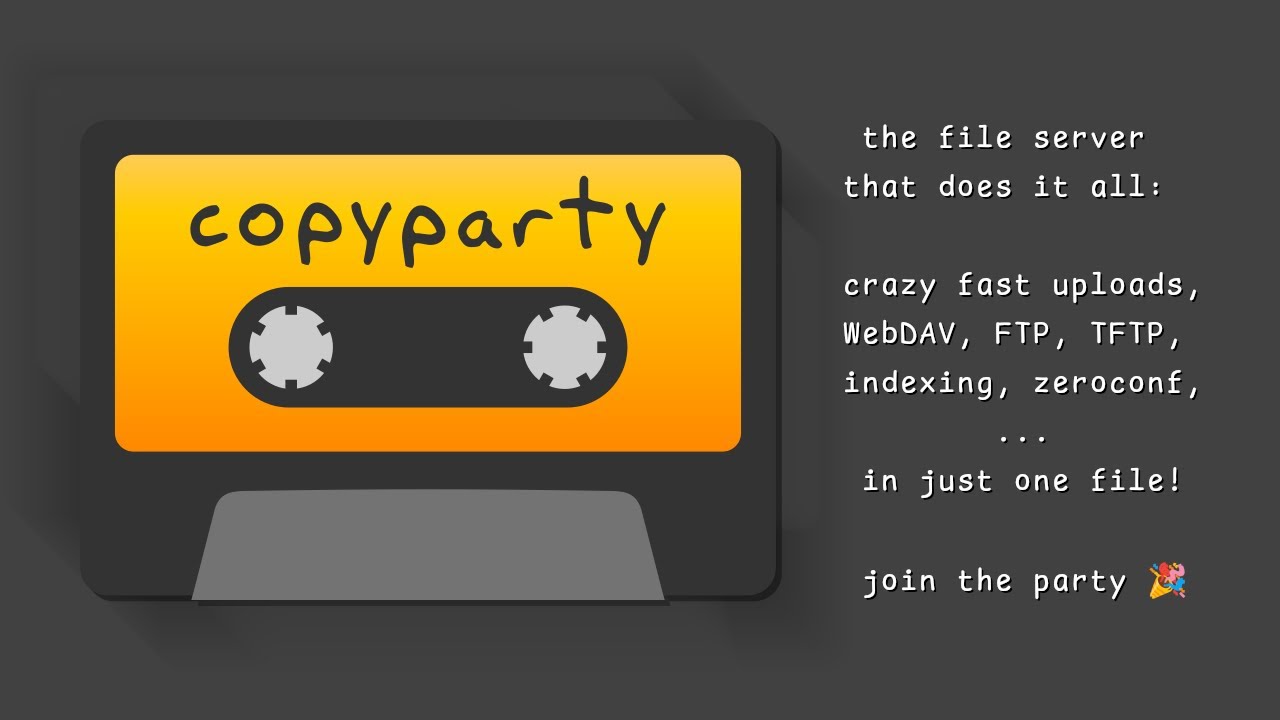I made a video about copyparty, the selfhosted fileserver I’ve been making for the past 5 years.
The main focus of the video is the features, but it also touches upon configuration. Was hoping it would be easier to follow than the readme on github… not sure how well that went, but hey :D
This video is also available to watch on the copyparty demo server, as a high-quality AV1 file and a lower-quality h264.
You made this on your phone on the bus ride to and from work.
I cleaned the cat box yesterday and considered that an accomplishment.
Fuck.
Congrats on the cat box cleaning!
Your readme looks super in depth, thanks for that! I haven’t watched the video yet but will later.
I didn’t see it mentioned from a quick glance, but is either sftp or ftps supported?
SFTP is not currently on the roadmap, but it’s not entirely implausible.
FTPS is supported, but it requires an optional dependency to be installed (pyopenssl), so it’s not available in the Windows EXE. And I just realized that the dependency is currently not present inside the docker images either, so I’ll get that fixed right away.
Elderly raspberry pi B [✓]
Large portable drive gathering dust [✓]
Guess I’m setting up a locally hosted file server in the near future.
Clearly a labour of love 👍
Maybe support for some music streaming apps (subsonic?) would be cool?
That’s a neat idea – I’ve heard that a lot of stuff uses the subsonic API under the hood, so I’ll see what it would take to become compatible with that. At first glance it looks like I’d have to mine and index way more information about audio files, but could still be doable :>
Hey fellow scener, cool project!
Just a few thoughts/questions:
- BTRFS and ZFS support real deduplication via copy on write, and would eliminate all current disadvantages of symlink and hardlink deduplication. It just works.
- Why have it be one huge python source file? This is a serious code smell imo, and something you really should avoid doing as this can be a major maintenance burden.
BTRFS and ZFS support real deduplication via copy on write, and would eliminate all current disadvantages of symlink and hardlink deduplication. It just works.
yeah that’s a good point, I’ll add an option to take advantage of this if you know you’re running on a filesystem where that works as intended.
Why have it be one huge python source file?
oh don’t worry, it’s all separate files during development – there’s a build-stage which bundles everything up into a single file for distribution. But thanks for the concern :D
What do you use to bundle into one file?
copyparty-sfx.pyis a custom packer (see this reply) created by make-sfx.sh, andcopyparty.pyzis a standard zipapp, created by make-pyz.sh. The zipapp has more disadvantages than thesfx.py, so that’s the default/recommended build.
Ah, so you have compiled it into one file? Didn’t know that was possible for python, what tool do you use for this?
sooo this is one of the things that started with someone saying “wouldn’t it be funny if…”
if you open copyparty-sfx.py in a text editor, you’ll see how – but please make sure to use an editor which is able to handle about 600 KiB of comments which contain invalid utf8 / binary garbage 😁
I ended up rolling my own packer since I wanted optimal encoding efficiency, and everything I could find would do stuff like base85 or ucs2 tricks, but it turns out python is perfectly happy with binary garbage in comments if you declare that the file is
latin-1so it realizes all hope is lost :Dthe only drawback of the sfx.py is that it needs to extract to $TEMP before running, so that’s the slight advantage of the zipapp (the .pyz alternative), but that suffers from some performance reduction in return, and is more hermetic (doesn’t let you swap out the bundled dependencies with fresh versions as easily if necessary)
I would probably remove python 2 support, it was end of life when the project was started.
As long as it’s not causing any issues or drawbacks for modern python versions (and it isn’t), I don’t see any reason to do that – on the contrary, I know people are running copyparty on retro equipment, so I’d very much prefer to keep it for as long as possible :>
Sometimes I feel so new to setting up my own digital ecosystem because I look at a thing and think “that’s so cool” but struggle to imagine it at home. So could someone help me understand.
This would be a replacement for something like Google Drive or Proton Drive? The actions I would use this for would be:
- sending files to friends
- managing a collection of files like PDFs, music, ISO’s that could be accessible by my friends (or just my household)
So I would spin this up on my NAS or my main PC and replace those services and accomplish those actions using this software?
Are there other services or actions I’m missing? Am I misunderstanding the premise entirely?
I think Copyparty would be great for that purpose. The only thing you’re missing is a way to expose it to the internet, such as a public IP or some tunnel
Yep! Depending on what your home connection looks like, you have a few options:
if you are lucky enough to have your own private IP-address and are able to open ports, then you’re almost done already – you can put copyparty on some port (or keep the default 3923), and then anyone could connect to it by going to https://your.ip.address:3923/
(with this approach, you will want to create your own HTTPS certificate so the traffic is properly encrypted – the best option here is to get a domain and get a certificate for the domain)
however, if you are behind CGNAT, meaning your internet provider has given you a shared IP-address, then people cannot connect directly to your home-PC. One way around that issue is by setting up a machine somewhere on the internet which bridges the gap back home to your PC. Cloudflare offers this as service, and this is explained in the copyparty readme – see the “at home” section for one way to do that.
if you are against using Cloudflare for idealistic reasons (they are becoming quite powerful since they run a whole lot of the internet), then you can set up a cheap VPS which serves the same purpose. That’s my setup, and how you are accessing the copyparty demo server right now – I have the cheapest VPS you can get from Hetzner. The VPS is running nginx, and it forwards the traffic to my homeserver through an SSH tunnel. I haven’t documented this approach in the copyparty readme, but I have a feeling a lot of other people have :>
I bumped into copyparty the other month when looking for a software that could let me transfer files to a friend with the ability to pause/resume. Didn’t bother with it, tried another software instead. Never really got it to work so I gave up on it.
Bumped into the YouTube video today, decided to give copyparty a shot, damn sir you’ve written a fine piece of software. It’s so easy to get up and configure. The UI is a bit janky, but charming at the same time. Thanks for all the hard work!
“It’s janky. It’s charming. It works. It’s Copyparty.” ®
Can we have Gopher support?
I was thinking of that!! But then I realized that even Firefox removed gopher support by now, so the joke was dead on arrival :P
Firefox isn’t that great for FTP either. Gopher still exists :-) and I’d love to use it even more.







